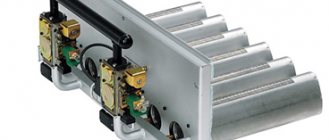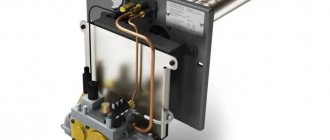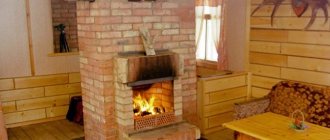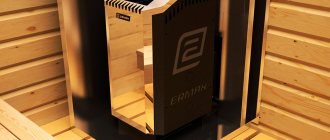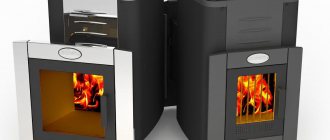Combustion process in a boiler
The chemical reaction inside the boiler is a combustion reaction between oxygen (O2) in the air and hydrocarbons (CHyOx) in the fuel, which release energy as heat. During the combustion process, water vapor (H2O) and carbon dioxide (CO2) are formed, the latter being especially dangerous in terms of air pollution and global warming.
Other combustion products of injector gas may also appear depending on the type of fuel and combustion conditions: oxides of nitrogen (NOx) or sulfur (SOx), which are responsible for acid rain. Carbon monoxide (CO), a dangerous toxic substance, can cause death if inhaled.
Correct adjustment of the device reduces the amount of harmful combustion products. CO2 emissions are reduced when the gas is completely burned. In order to reduce NOx emissions, it is recommended to use the correct combustion technology, which is ensured by the design of the burner device.
Space heating devices
They mix fuel and oxygen and, with the help of an ignition device, ensure complete combustion, which occurs in the combustion chamber, and the heat is transferred to water through a heat exchanger. Control devices regulate ignition, combustion speed, fuel and air supply, exhaust draft, water temperature, steam and water pressure in the boiler.
The hot water produced by the boiler moves through natural circulation through the in-house heating system of the entire building. The heating circuit may include hot water heat exchangers, air conditioning and ventilation units.
Device classification
The industry produces a very large number of gas injectors of various types, purposes and designs, which are strictly classified by type of fuel and method of air supply. Air supply classification:
- Atmospheric burners are burners in which air is supplied naturally; it is captured in a Venturi tube by a gas stream using the principle of an injector.
- Forced air or pulse burners are equipped with a fan that provides air flow for combustion of the air-fuel mixture and removal of products resulting from fuel combustion.
The gas burner for the stove in the house is divided by type of fuel:
- Gas for burning gaseous fuel.
- Burner for burning liquid fuel.
Ignition type
All burners can be divided according to the type of ignition:
- Electronic type . They do not have a constantly working igniter. Requires electricity to operate. Electric ignition is one of the most convenient inventions for modern heating units. Thanks to him, the operation of the stoves has become as comfortable as possible. Electric ignition makes it possible to light the burner flame safely, without using available wicks or lighters.
- Burners with piezo ignition . No electricity needed.
Sometimes special working conditions are required, for example, burners are placed in a sauna stove, which must distribute the flame well. These are dividers or ordinary distribution tubes. This is how kitchen gas ovens work.
Operating principle of an atmospheric burner
The gas, entering the nozzle nozzle, increases its speed and creates a vacuum at the base of the torch, which sucks in part of the combustion air, the so-called primary air, forming a gas-air mixture.
The main air-gas mixture enters a series of holes (circular, inclined, straight) located on one or several tiers of the device. The mixture is ignited using a pilot light. The additional air required for combustion, called secondary air, is drawn into the flame by induction due to natural convection.
A homemade gas burner for heating with domestic gas has a percentage of primary air from 40 to 50%. All parts of the device (nozzles, mixing tubes) structurally ensure stable combustion of fuel without loss. However, this type of burner does not have the ability to manually control the combustion process. The combustion process is strictly ensured by the burner design and fuel parameters.
While the big advantage of boilers equipped with an atmospheric burner (power up to 1 MW) is the simplicity of the system, they have major disadvantages:
- no emergency shutdown of the combustion process during operation of a brick kiln in the event of a sudden stop in the fuel supply;
- excess air;
- poor combustion efficiency;
- significant production of NOx.
DIY options
Often, a homemade gas heating unit is made from an old empty cylinder, which is first filled with water to remove any remaining fuel. To assemble a metal heat generator with your own hands, use ready-made drawings.
Materials and tools:
- empty gas cylinder. You can buy a new cylinder or find a used one at a scrap metal collection point,
- used wheels from trucks and cars, they are selected depending on the expected power of gas-fuel heating equipment,
- metal pipes. For gas and air supply, a model with a cross section of 2 cm is used; for the construction of a chimney, a pipe with a diameter of 4 cm is suitable,
- atmospheric burner,
- Bulgarian,
- drill with appropriate attachments,
- welding machine.
Sequence of work:
- Using a grinder, cut a hole in the upper part of the cylinder to fit the dimensions of the wheel rim.
- The disk is inserted into the hole and welded using a welding machine.
- The air supply structure is made from a pipe d2 cm by drilling 9-11 holes with a diameter of 5 mm on the surface.
- A hole d50 mm is drilled in the lower part of the cylinder, a pipe is inserted so that on one side it protrudes 15-20 cm. The seams are sealed by welding.
- The gas pipe is welded in a similar way, the free end is equipped with an adapter for connection.
- A chimney is installed in the upper part of the structure.
At the end, the firebox door is made from a steel plate, a hole is cut out from the side of the homemade structure for it and installed on the hinges.
Hand-drawn diagram of a homemade gas burner for a sauna stove
Pulse burner design
It has a higher efficiency compared to natural ones, is more efficient and complex in design. The fuel burner consists mainly of seven elements:
- Fuel pump, it supplies the boiler with fuel from the tank (liquid fuel) and is equipped with a pressure regulator that returns the excess fuel required for combustion.
- The fan provides the combustion process with the air necessary to burn the fuel.
- A solenoid valve is a valve that operates automatically. It is used to supply a jet of fuel in sufficient quantity for combustion.
- The nozzles are the central part of the burner. The nozzle allows the fuel to be atomized very finely to promote thorough mixing with air to form a fuel-air mixture for combustion.
- A fuel heater, it allows the liquid fuel contained in the tank to be made less viscous to aid combustion. This initial viscosity is related to the storage temperature in the tank as well as the specific characteristics of the fuel.
- Electrodes, they allow you to ignite the gas-air mixture to create the desired flame.
- The combustion head, which consists of two elements. The tip that directs the flame and the reflector that holds the flame in the stove.
The burner operating mode can be divided sequentially into stages:
- Pre-ignition. Turning on the fan, which allows the engine to run.
- Ignition. Opening of the solenoid valve, which directs fuel to the nozzle.
- Ignition. A spark is created to maintain a stable combustion flame.
- Operating mode. Turn off the igniter after the flame has stabilized.
- Stop. Closing the solenoid valve, turning off the burner and after 15 - 20 minutes of ventilation of the firebox in order to free the combustion space from explosive mixtures, turning off the fan.
Homemade units
There are craftsmen who remake heating systems with their own hands. On the Internet you can even find the necessary diagrams for changing the devices of gas burners, their installation and adjustment.
Typically, metal is used as a material for the manufacture of heating systems. A cast iron firebox would be much more reliable. However, it is not possible to use it at home.
An excellent option for manual work is to order the system from specialists. They will be able to manufacture the device in accordance with all the customer’s wishes. However, the possibility of defects in the boilers cannot be ruled out, which may appear after some time.
Why do you need homemade heating units? The fact is that the marked options have a lower cost. They are made mainly because of the desire to save money. At the same time, these options are inferior to their factory counterparts in efficiency.
Usually only solid fuel and electric units are manufactured. Making a gas or diesel boiler is extremely dangerous. In addition, their installation in the house is strictly prohibited.
According to the principle of operation, a homemade product is no different from a purchased version. It will burn fuel and heat the coolant filled with water.
The main disadvantage of this unit is the lack of warranty. Factory equipment will work and perform its functions. Even if the buyer stumbles upon a defect, he will be able to exchange the product for another.
It is better to use pellets, firewood, and coal as fuel in self-made units. These materials are less dangerous than gas. It is impossible to make heating devices based on the latter.
Simple solid fuel units are the most popular and widespread homemade devices. They are simple, and their design is in many ways similar to a conventional stove. In addition, they are versatile.
Like a conventional stove, these systems can operate on any solid fuel. The main thing is that it burns.
Main parts of a gas boiler.
The efficiency of homemade equipment is significantly lower than factory equipment. It is influenced by many factors.
Among them:
- thermal insulation;
- combustion completeness;
- the correctness of the conclusions.
The efficiency of the unit directly depends on the combustion temperature. The higher it is, the lower the efficiency. In high-quality systems, the temperature in the firebox is maintained at 120–150°C. Higher values reduce the safety of pipes. This in turn significantly reduces the durability of the unit.
When manufacturing heating boilers with a burner, it is better to protect yourself as much as possible from the possible consequences of its operation. Therefore, you should consider a separate purchase of an automatic gas burner, which will be installed in an atmospheric or blown boiler.
You can also make electric heating units with your own hands. Their design may vary. It all depends on the person’s needs. The simplest option is to install a heating element directly into the heating system. In this case, there is no need to make a boiler.
The pipe with the heater must have a sufficiently large diameter. It should be easily removable for repairs and cleaning.
Systems without a heater deserve special attention. Its role is played by water itself. A current is passed through it, and heating occurs due to the movement of water ions. The liquid itself must contain salt.
It is extremely difficult to make such a device. Electric current passes directly through the coolant, so the entire system must be reliably insulated.
One of the dangers of this device is electrical breakdown. Essentially the same as a short circuit. Gas may also accumulate in the system. As a result, heating efficiency will decrease.
From all of the above, the best option is a solid fuel unit. Its body can be assembled from heat-resistant steel. It is characterized by increased strength, less wear and high resistance to thermal influences.
However, heat-resistant steel is expensive and in practice is rarely used in homemade boilers. Another option is cast iron: this material tolerates heat well, although it is difficult to work with. Equipment for the manufacture of cast iron stoves is available only at specialized enterprises.
It is important to understand that without the proper experience and skills, it is better not to make a heating system yourself. Safety must come first
It is enough to make even one inaccuracy, and this can lead to disastrous consequences.
Oven nozzle
Gas stove burner is used to burn gaseous fuels such as gas. They are available as atmospheric or pulse burners. When comparing the two systems, especially the blower burners provide very clean and efficient combustion of gas products in all power ranges by precisely controlling the supply of fuel and combustion air.
Modern and compact heaters currently use mainly flat burners, in which the flame is distributed over several nozzles over a larger area. The operator's hand makes the combustion particularly efficient and also cleaner due to the lower temperature. Particularly favorable and clean is the so-called catalytic combustion, in which the gas enters into a chemical oxidation reaction on the surface of the catalyst with oxygen from the air. This process does not require conventional ignition and is characterized by a very low flame temperature.
Required Permissions and Installation Requirements
To install a burner in a sauna stove, permission from the gas supply authorities is required. In the case of atmospheric devices, operating conditions must meet the following requirements:
- the presence of a high-quality room ventilation system,
- adjustable traction,
- the volume of the premises being used is at least 12 m³,
- ensuring fire safety measures: reliable insulation of the chimney when laying the chimney through the floor slabs and roofing system, equipping the top with a spark arrester.
When purchasing a device, a set of documents is included in the form of certificates of conformity and permission from Rostechnadzor. If the installation rules are followed and the above documentation is available, there is a chance to obtain permission for operation from the gas supply organization.
When installing supercharged models, it is sufficient to comply with fire safety rules and the availability of accompanying documentation, since due to the features of the functionality, there are no requirements for the place of operation.
It is worth considering that all this is valid when using main gas. In the case of autonomous gasification, for storing liquefied gas cylinders, according to the regulations, a separate metal cabinet is used or a gas tank is equipped. The underground tank provides for volumes of 3 m³ and a location at least 5 m from the building. A pipeline of steel pipes is laid from the storage facility to the heat generator, ensuring reliable tightness of the channel.
Liquid fuel combustion device
These burners are used to burn liquid fuels such as low sulfur fuel oil, diesel fuel or biofuels. Unlike gas, this type of fuel must be atomized to a gas state. If this is not done, large drops of fuel oil will enter the combustion chamber.
They will not be able to burn completely and will cause the formation of soot, which will settle on the heat exchanger and reduce the useful heating surface of the boiler. These burners at one time offered a pressurized combustion process, as blower burners, due to which the necessary air was mechanically supplied to the combustion point. According to the color of the flame, a distinction is made between so-called yellow and blue burners.
While yellow burners atomize liquid fuel, blue burners use part of the combustion heat to completely evaporate the fuel oil. This way, less soot is produced and combustion occurs at higher temperatures - hence the blue color.
Since clean combustion always depends on sufficient throughput of liquid fuel and its sufficient quantity, the use of such burners in everyday life is limited compared to gas burners.
Gas equipment safety system
The safety system allows you to continuously monitor the burner flame. This control is provided by either a photosensitive photocell generated by the flame or a photocell sensitive to light radiation. The system automatically warns the user in the following cases:
- flame does not appear when fuel is supplied;
- torch breakage during combustion;
- the burner does not work.
Thanks to this control system, the boiler does not have unburned fuel, which can cause an explosion of the gas-air mixture in the boiler furnace. To ensure reliable and trouble-free operation of the boiler, the burner must perform the following functions:
- fuel ignition;
- automatic fuel supply and processing;
- combustion air supply;
- complete combustion of fuel;
- power regulation.
How to choose?
What you need to pay attention to when choosing a burner device for a boiler:
- productive power - noise level during operation (applies to supercharged models) - type of heating equipment for which the burner is purchased - type of fuel - pros and cons of this device - provide for possible malfunctions in the operation of the local gas supply line.
Taking these factors into account, you can choose the most suitable burner device for your boiler so that it operates as efficiently as possible without the burden of frequent preventative maintenance.
Trouble-shooting
Having a boiler at home brings many advantages, but it also has a number of disadvantages, and the user does not always know what to do correctly. Boiler faults are common to many types. It is important to promptly determine the cause of these faults before calling emergency services. List of the most common and most likely faults.
First of all, if the boiler does not start, you need to check the circuit components:
- network voltage;
- faulty boiler fan switch or motor;
- damaged boiler cables;
- false triggering contacts of automation or commissioning equipment;
- availability of water, whether the gas boiler is powered to the minimum required level specified by the equipment manufacturer.
If the boiler failure is not caused by any of these problems, the following procedure:
- Pay attention to the noises made by the boiler, because they are often the first witnesses of destruction. They can also be due to hot water trapped inside the firebox or due to the presence of air in the heating system due to clogged air ducts.
- Pipe rupture. It usually occurs due to problems with a jammed boiler feed valve, various scale-forming deposits in the boiler, or a malfunction of the condensate drainage systems.
- Failures due to exceeding the pressure and temperature readings, their corresponding sensors can trigger, for example, due to a broken thermometer or, conversely, which is especially dangerous as a result of real overheating of the boiler.
- The heating circuits are not working, possibly due to poor quality of feed water and scale formation in the boiler pipes.
- A problem occurs with the burner (flame breaks, gas accumulation causes detonation and explosion).
For some of these problems, mainly pressure or temperature, the boiler monitor displays an error message, then the system shuts down and automatically restarts. If the problem persists after restarting, it is best to call a professional to troubleshoot the problem. It should be noted, however, that most of these failures can be avoided.
The best prevention is to have your boiler inspected, maintained and cleaned annually, usually by a professional. This will prevent the pipes from clogging and bursting. Prevention is better than restoration, and a simple annual inspection will protect the equipment and the health of users from possible emergency situations.
Criterias of choice
Important requirements for gas welding equipment are lightness and compactness. If these points are not provided, it will be more difficult to move the devices. When choosing the acetylene torches themselves, you should immediately take into account that they are divided into 2 types: one is designed for welding, and the other is for cutting metal. The difference between burner devices in terms of power is also relevant. There are 4 main classes:
low-power (with tips 1-4, for metal from 0.3 to 7 mm);
intermediate level (tips 5-7, work with products with a thickness of 7-30 mm);
GAO-2 (used in cleaning surfaces);
non-injector (main application is welding with pressure 0.01-0.08 MPa).
The most efficient devices of 2018
The most efficient certified boilers and gas burners this year:
- Bosch Greenstar series. The boiler is small, very quiet, environmentally friendly and uses economical condensing technology providing an AFUE rating of 95%. Greenstar is available in two models - combi for spatial and point-less water heating or space heating, which can be used with domestic hot water tanks. It is equipped with a heat exchanger with a 5-year warranty.
- Bradford White Brute Elite Series. The boiler with 95% efficiency has a condensing multi-pass stainless steel heat exchanger with an advanced modulation system. Innovative design features make Brute Elite easy to install in both new and existing heating systems.
- Bradford White Brute Elite 125 Series. Customizable combi based heating only models are 95% efficient with a combi unit providing heating and hot water from one unit. Requires only one gas connection, one ventilation system and built-in expansion tank and boiler pump, and is easily accessible for repairs.
- Buderus GB142 series. Condensing gas boiler. Using state-of-the-art condensing technology with 95% AFUE, the Boer Buderus GB142 wall-mounted condenser maximizes the heating value of every m3 of natural gas or liquefied propane.
- Boiler Alpine Series. This is a natural or liquefied gas condensing hot water boiler with a stainless steel heat exchanger. Equipped with Sage2 boiler control system. 1 TM, which supports multiple firing speeds, is also equipped with an external reset and a touch interface.
- Carrier BMW Performance Series. 95% AFUE. Stainless steel. The modulating condensing boiler is equipped with a unique vertically oriented stainless steel heat exchanger, 5 to 1 ratio, compact design with light weight, compact wall mounting, primary and secondary piping, with a 15-year warranty.
Having familiarized yourself with the design and operating principle of gas burners and popular models, you can easily choose exactly what suits your needs.
